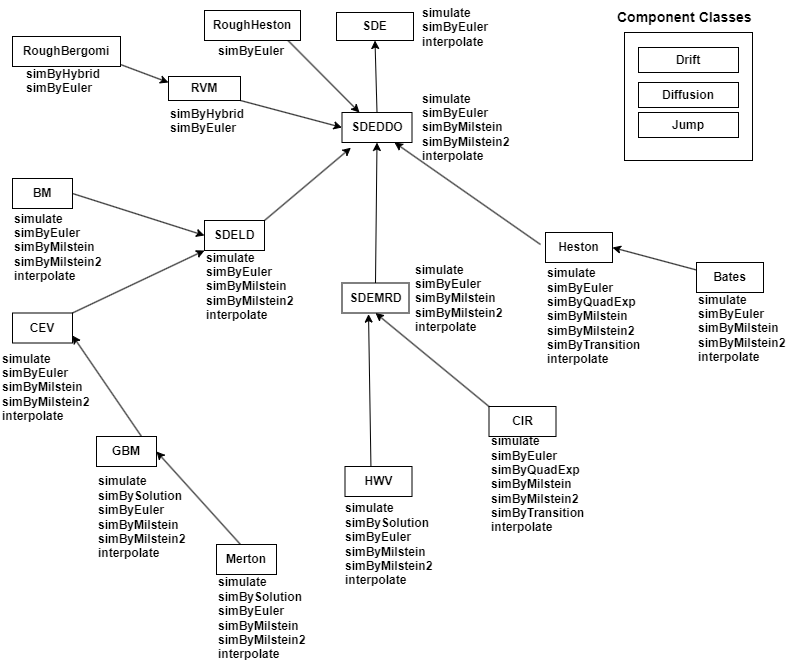roughbergomi
Description
Creates and displays a roughbergomi object.
Rough Bergomi models are bivariate composite models, composed of two coupled and
dissimilar univariate models, each driven by a single Brownian motion source of risk
over NPERIODS consecutive observation periods, approximating
continuous-time rough stochastic volatility processes.
The first univariate model is a geometric Brownian motion (GBM) model with a stochastic volatility function, and usually corresponds to a price process whose variance rate is governed by the second univariate model. The second model includes a Volterra process (Riemann-Liouville) which induces the rough behavior of the variance rate (modeling log variance) of the coupled GBM price process.
Creation
Description
RoughBergomi = roughbergomi(Return,Alpha,Xi,Eta)RoughBergomi object with Properties for these required
arguments.
Specify the required input parameters as one of the following types:
A MATLAB® array. Specifying an array indicates a static (non-time-varying) parametric specification. This array fully captures all implementation details, which are clearly associated with a parametric form.
A MATLAB function. Specifying a function provides indirect support for virtually any static, dynamic, linear, or nonlinear model. This parameter is supported through an interface because all implementation details are hidden and fully encapsulated by the function.
Note
You can specify combinations of array and function input
parameters as needed. Moreover, a parameter is identified as a
deterministic function of time if the function accepts a scalar time
t as its only input argument. Otherwise, a
parameter is assumed to be a function of time t
and state X(t) and is invoked with both input
arguments.
RoughBergomi = roughbergomi(___,Name=Value)RoughBergomi object with additional options
specified by one or more name-value arguments to set the properties.
Input Arguments
Name-Value Arguments
Output Arguments
Properties
Object Functions
simByEuler | Simulate RVM, roughbergomi, or
roughheston sample paths by Euler approximation |
simByHybrid | Simulate RVM or roughbergomi sample paths
by hybrid approximation |
Examples
More About
Algorithms
The rough Bergomi model is a type of stochastic volatility model, which means it assumes that the volatility of the underlying asset is not constant but varies over time and is not necessarily correlated with the asset price.
The first and second equations represent a geometric Brownian motion (GBM) model with a stochastic volatility function.
The third equation represents the process describing the evolution of the variance rate of the coupled GBM process, where Yt is a Volterra process. In a Volterra process, the increments are not only dependent on the current state of the process but also on the entire history of the process. This means that the current state of the process is determined by integrating a function over the entire past trajectory of the process, as opposed to just the most recent state.
References
[1] Bayer, C., P. Friz, and J. Gatheral. “Pricing Under Rough Volatility.” Quantitative Finance. Vol. 16, No. 6 , 2016, pp. 887–904.
Version History
Introduced in R2024a
See Also
simByEuler | simByHybrid | nearcorr | rvm | roughheston
Topics
- Simulating Equity Prices
- Simulating Interest Rates
- Stratified Sampling
- Price American Basket Options Using Standard Monte Carlo and Quasi-Monte Carlo Simulation
- Base SDE Models
- Drift and Diffusion Models
- Linear Drift Models
- Parametric Models
- SDEs
- SDE Models
- SDE Class Hierarchy
- Quasi-Monte Carlo Simulation
- Performance Considerations
